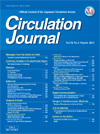Volume 74, Issue 1
Displaying 1-36 of 36 articles from this issue
- |<
- <
- 1
- >
- >|
Massage From the Editor-in-Chief
-
2010Volume 74Issue 1 Pages 1-2
Published: 2010
Released on J-STAGE: December 25, 2009
Download PDF (283K)
Reviews
-
2010Volume 74Issue 1 Pages 3-12
Published: 2010
Released on J-STAGE: December 25, 2009
Advance online publication: December 08, 2009Download PDF (1412K) -
2010Volume 74Issue 1 Pages 13-17
Published: 2010
Released on J-STAGE: December 25, 2009
Advance online publication: November 17, 2009Download PDF (795K) -
2010Volume 74Issue 1 Pages 18-23
Published: 2010
Released on J-STAGE: December 25, 2009
Advance online publication: November 18, 2009Download PDF (562K) -
2010Volume 74Issue 1 Pages 24-33
Published: 2010
Released on J-STAGE: December 25, 2009
Advance online publication: November 17, 2009Download PDF (1614K) -
2010Volume 74Issue 1 Pages 34-40
Published: 2010
Released on J-STAGE: December 25, 2009
Advance online publication: December 05, 2009Download PDF (1146K)
Editorials
-
2010Volume 74Issue 1 Pages 41-42
Published: 2010
Released on J-STAGE: December 25, 2009
Download PDF (187K) -
2010Volume 74Issue 1 Pages 43-44
Published: 2010
Released on J-STAGE: December 25, 2009
Download PDF (189K) -
2010Volume 74Issue 1 Pages 45-46
Published: 2010
Released on J-STAGE: December 25, 2009
Download PDF (189K) -
2010Volume 74Issue 1 Pages 47-48
Published: 2010
Released on J-STAGE: December 25, 2009
Download PDF (188K) -
2010Volume 74Issue 1 Pages 49-50
Published: 2010
Released on J-STAGE: December 25, 2009
Download PDF (345K)
Original Articles
Aortic Disease
-
2010Volume 74Issue 1 Pages 51-58
Published: 2010
Released on J-STAGE: December 25, 2009
Advance online publication: December 05, 2009Download PDF (600K)
Arrhythmia/Electrophysiology
-
2010Volume 74Issue 1 Pages 59-65
Published: 2010
Released on J-STAGE: December 25, 2009
Advance online publication: November 18, 2009Download PDF (577K) -
2010Volume 74Issue 1 Pages 66-70
Published: 2010
Released on J-STAGE: December 25, 2009
Advance online publication: October 02, 2009Download PDF (302K) -
2010Volume 74Issue 1 Pages 71-76
Published: 2010
Released on J-STAGE: December 25, 2009
Advance online publication: December 02, 2009Download PDF (936K)
Cardiovascular Surgery
-
2010Volume 74Issue 1 Pages 77-85
Published: 2010
Released on J-STAGE: December 25, 2009
Advance online publication: November 27, 2009Download PDF (413K) -
2010Volume 74Issue 1 Pages 86-92
Published: 2010
Released on J-STAGE: December 25, 2009
Advance online publication: November 27, 2009Download PDF (1053K)
Epidemiology
-
2010Volume 74Issue 1 Pages 93-100
Published: 2010
Released on J-STAGE: December 25, 2009
Advance online publication: November 27, 2009Download PDF (5217K)
Heart Failure
-
2010Volume 74Issue 1 Pages 101-108
Published: 2010
Released on J-STAGE: December 25, 2009
Advance online publication: December 07, 2009Download PDF (1755K) -
2010Volume 74Issue 1 Pages 109-119
Published: 2010
Released on J-STAGE: December 25, 2009
Advance online publication: December 07, 2009Download PDF (7383K) -
2010Volume 74Issue 1 Pages 120-128
Published: 2010
Released on J-STAGE: December 25, 2009
Advance online publication: December 07, 2009Download PDF (1796K)
Hypertension and Circulatory Control
-
2010Volume 74Issue 1 Pages 129-136
Published: 2010
Released on J-STAGE: December 25, 2009
Advance online publication: December 02, 2009Download PDF (801K)
Imaging
-
2010Volume 74Issue 1 Pages 137-141
Published: 2010
Released on J-STAGE: December 25, 2009
Advance online publication: December 05, 2009Download PDF (415K)
Ischemic Heart Disease
-
2010Volume 74Issue 1 Pages 142-147
Published: 2010
Released on J-STAGE: December 25, 2009
Advance online publication: December 02, 2009Download PDF (1023K) -
2010Volume 74Issue 1 Pages 148-155
Published: 2010
Released on J-STAGE: December 25, 2009
Advance online publication: December 02, 2009Download PDF (467K)
Molecular Cardiology
-
2010Volume 74Issue 1 Pages 156-162
Published: 2010
Released on J-STAGE: December 25, 2009
Advance online publication: December 07, 2009Download PDF (613K)
Myocardial Disease
-
2010Volume 74Issue 1 Pages 163-170
Published: 2010
Released on J-STAGE: December 25, 2009
Advance online publication: November 27, 2009Download PDF (511K)
Pediatric Cardiology and Adult Congenital Heart Disease
-
2010Volume 74Issue 1 Pages 171-180
Published: 2010
Released on J-STAGE: December 25, 2009
Advance online publication: December 02, 2009Download PDF (2286K)
Peripheral Vascular Disease
-
2010Volume 74Issue 1 Pages 181-187
Published: 2010
Released on J-STAGE: December 25, 2009
Advance online publication: December 05, 2009Download PDF (362K)
Regenerative Medicine
-
2010Volume 74Issue 1 Pages 188-194
Published: 2010
Released on J-STAGE: December 25, 2009
Advance online publication: November 19, 2009Download PDF (617K)
Vascular Medicine
-
2010Volume 74Issue 1 Pages 195-202
Published: 2010
Released on J-STAGE: December 25, 2009
Advance online publication: November 19, 2009Download PDF (386K)
Rapid Communication
-
2010Volume 74Issue 1 Pages 203-206
Published: 2010
Released on J-STAGE: December 25, 2009
Advance online publication: December 05, 2009Download PDF (1451K)
Letters to the Editor
-
2010Volume 74Issue 1 Pages 207
Published: 2010
Released on J-STAGE: December 25, 2009
Download PDF (187K)
Author's Reply
-
2010Volume 74Issue 1 Pages 208-209
Published: 2010
Released on J-STAGE: December 25, 2009
Download PDF (194K)
-
2010Volume 74Issue 1 Pages Cover1
Published: 2010
Released on J-STAGE: December 25, 2009
Download PDF (1839K) -
2010Volume 74Issue 1 Pages Content1
Published: 2010
Released on J-STAGE: December 25, 2009
Download PDF (159K)
- |<
- <
- 1
- >
- >|
